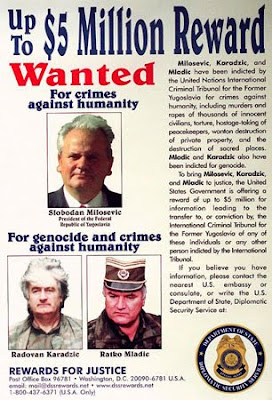 by Maxime Gauin, 2 August 2011
by Maxime Gauin, 2 August 2011
In July 2011, the commemoration of the genocidal massacre at Srebrenica, particularly in Istanbul, and the more recently the arrest of GoranHadzic, recalled the extensive practice of ethnic cleansing by Serbian forces during the Yugoslav Civil War. If no one belligerent side was innocent of war crimes, the fact remains only Serbian forces engaged in the massacre of thousands of unarmed civilians with the intent to commit genocide, in the precise case of Srebrenica.
The background of these massacres was studied particularly within the texts of Serbian nationalist ideologues and other relevant published and translated documents, illustrating the progression from the expulsion of Belgrade’s Muslims (“Turks”) in 1807 to the atrocities of the 1990s (Grmek, Gjidara, & Simac). However, one of the roots of this ideological motivation is almost never stressed: the affinities between Serbian nationalism — including Slobodan Milosevic — and Armenian nationalism — including its propagandists and lobbyists who are welcomed by some prominent politicians in the USA and Western Europe. . . .
The Armenian nationalists had especially been intrigued by ethnic cleansing. They dreamed of a “Greater Armenia”, from the Black Sea to the Mediterranean, a large territory inhabited by a Muslim majority — hence this design being referred to as the fantasy of “Armenian megalomaniacs” by the pro-Armenian Colonel Chardigny, a member of the French military mission in the Caucasus(“La question arménienne”, 1919).If the main inspiration of the Armenian nationalists was the Bulgarian revolutionary committees, the Serbian, Greek, and Montenegrin nationalists were seen as inspirations and allies. Today, the Armenian Revolutionary Federation (ARF-Dashnak), the Hunchak party, and other organizations still advocate for a “Wilsonian Armenia” that would include about one quarter of Turkish territory. That Azerbaijan was subjected to these expansionist designs and so can testify that these ideas are not merely a theory.
The assassination of Galip Balkar, the Turkish ambassador in Belgrade, on March 9, 1983, offered an opportunity for a concrete revival of the solidarity between Armenian and Serbian nationalists. Galip Balkar was murdered by the terrorist branch of the ARF-Dashnak who received, as usual, the unconditional support of the legal branches of this political party, including newspapers such as The Armenian Weekly (Boston) and Haïastan (Paris)which justified the assassination. The Armenian Weekly (January 14, 1984) in particular reproduced the message of the Armenian National Committee-Eastern Region (affiliated to the ARF-Dashnak) to the Yugoslav authorities on the front page. At the end of this text, there is self-explanatory appeal: “The Armenian people and the Yugoslavians have a fraternal relationship that spans centuries. Together they have fought the common enemy: Turkey.”
However, in 1984, Yugoslavia was still ruled by orthodox communists, and in addition, the two Dashnak terrorists committed the serious error of having killed one Yugoslav citizen and wounded another. As a result, the tribunal refused to listen to “Armenian genocide” claims and sentenced the two terrorists, RaffiElbekian and HarutyunLevonian, to twenty years in prison, the maximum punishment of the Yugoslavian penal codein this kind of case.
The situation changed some years later. Slobodan Milosevic became President of Yugoslavia in 1989. As early as 1990, he paroled Raffi Elbekian, and the terrorist expressed his thanks to him (Þimþir, p. 687-689). Harutyun Levonian had been released in 1987, for health reasons.
About two years after Mr. Elbekian’s release, the Serbian armed forces attacked Muslims and Croats to create a “Greater Serbia.” One of the favorite rallying cries of the Serbian war criminals was “Kill the Turks!” — underlining the continuity of previous wars and ethnic cleansing, against the Ottoman Empire and Ottoman Muslim civilians. The call of the US Dashnaks in 1984 was eventually answered and its objective carried out.
Works cited:
Mirko Grmek, Marc Gjidara, and NevenSimac. Le Nettoyage ethnique : Documents historiques sur une idéologie serbe. Paris: Fayard Publishers, 1993; second edition, Le Seuil Publishers, 2002.
“La question arménienne. 30 octobre 1919”, Service historique de la défense nationale, 16 N 3187, classeur 39.
Bilâl N. Simsir, Sehit Diplomatlarimiz (1973-1994), Ankara-Istanbul, Bilgi Yayinevi, 2000, vol. II.
http://www.turkishweekly.net/
.

0 comments:
Post a Comment
Please Update/Correct Any Of The
3700+ Posts by Leaving Your Comments Here
- - - YOUR OPINION Matters To Us - - -
We Promise To Publish Them Even If We May Not Share The Same View
Mind You,
You Would Not Be Allowed Such Freedom In Most Of The Other Sites At All.
You understand that the site content express the author's views, not necessarily those of the site. You also agree that you will not post any material which is false, hateful, threatening, invasive of a person’s privacy, or in violation of any law.
- Please READ the POST FIRST then enter YOUR comment in English by referring to the SPECIFIC POINTS in the post and DO preview your comment for proper grammar /spelling.
-Need to correct the one you have already sent?
please enter a -New Comment- We'll keep the latest version
- Spammers: Your comment will appear here only in your dreams
More . . :
http://armenians-1915.blogspot.com/2007/05/Submit-Your-Article.html
All the best